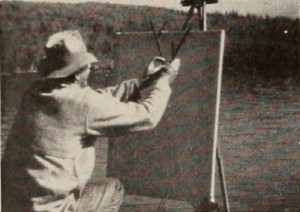
"In Lake Superior Landscape, the artist, Dewey Albinson, demonstrates his technique of landscape painting from the bare canvas stage to the climactic moment when the glowingly finished product is first exhibited. Shot by Elmer Albinson, the film is marked by vivid closeups and many changing angles, which help immeasurably to achieve a comprehensive sense of growth as the painting progresses. Producer Albinson understands the relationship that exists between the object, the artist and the painting; he has used his camera with accuracy and sensitivity to pass this understanding on to those who see his film." Movie Makers, Dec. 1947, 538.
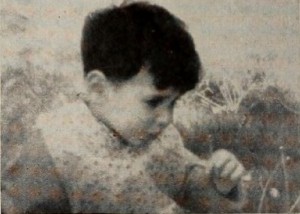
"Irwin Sharpe and Cye Landy have gone back to film beginnings in composing their engaging little etude, Picnic. The fundamental of their selection is the old reliable device of the chase sequence. Beginning quietly with a simple family picnic, the producers soon overlay on this bucolic subject a mysterious kidnapping and its resultant chase. The cutting, camera positions and tempo of this climactic sequence show a true understanding of cinematic expression." Movie Makers, Dec. 1947, 538-539.
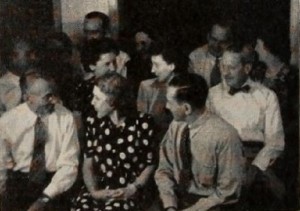
"This clever 16mm. picture is amazing in several ways, but two characteristics stand out. It is only 250 feet long and it was completely filmed, with the exception of the double exposed titles, in one evening. George Merz, the producer of this novel study, warned his guests that, when they came to see the Louis-Conn fight televised, they would have to earn their way by acting in his production. Ringside Seats at Home shows the guests arriving, reacting to the fight and paying off bets. It also contains surprisingly clear footage of the fight itself, including the knockout in the eighth round. A unique and attractive picture, the movie shows what can be done if you work a little, pray a little and gamble a lot." Movie Makers, Dec. 1947, 539.
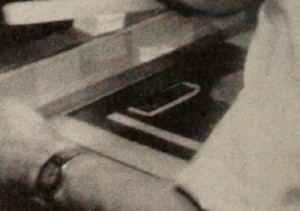
"No matter how one feels about the outside cover of a magazine, George E. Valentine's The Inside Story of the Outside Cover will be a surprise. If you think that the production of four color engraving plates is a simple matter, you will do some quick revising of your thinking. If you have a certain admiration for the technical skill that goes into such work, that admiration is likely to be heightened by Mr. Valentine's step by step story of the creation of a four color magazine cover. Aside from the story it tells, Mr. Valentine's film is a real technical achievement because of the working conditions under which most of the shots were of necessity filmed. His peak sequence — a proof-press run analyzed in slow motion — was achieved by mounting the camera directly on the moving press. When you can do that, you're good." Movie Makers, Dec. 1947, 539.
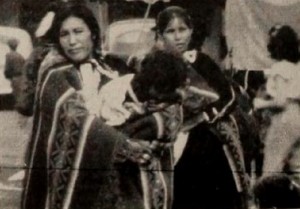
"Edward F. Cross covered an extensive territory of national parks and vacation spots in the Southwest and Western sectors of the United States and has brought back an attractively filmed record of his tour. Unique rock formations have been pictured from well chosen vantage points to make the most of light and shadow. This Land of Ours is climaxed by particularly colorful units in a rodeo's grand parade and a dexterous camera handling of Indian dances. A full narrative indicates careful research to supplement the scenes on the screen." Movie Makers, Dec. 1947, 539.
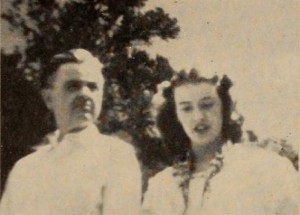
"Basing his story line on an incident which is said actually to have occurred in Sweden, Harry W. Atwood has proved once again in Through the Valley his imaginative understanding of what makes a true motion picture. For here is camera work of the first order, expressed in meaningful angles and building through a stirring chase sequence to a point of very real dramatic tension. If anything, the film's climax has been staged with a shade too much of melodrama, while a concluding quotation from the Scriptures left these reviewers regretfully more puzzled than uplifted." Movie Makers, Dec. 1949, 471.
"'Indian Summer,' properly may be termed a poem on film. Bert Seckendorf took his camera into the great outdoors one autumn day and photographed many beautiful autumnal scenes which he then skillfully knit together in a smooth flowing pictorial continuity. Scenes of colorful autumn foliage, falling leaves, blue Indian Summer skies, lazy rivulets carrying tiny sailboats of leaves toward the sea -all add up to an impressive ten minutes of screen entertainment. Seckendorf photographed this picture with a Cine Special and Kodachrome film." American Cinematographer, Apr. 1950, 146.
"Another form of humor is delightfully explored in The Farmer's Daughter, by Clarence Aldrich, ACL, a burlesque of the girl-hero-villain triangle. The chase sequence, without which no such film is ever complete, is beautifully handled with many a touch reminiscent of the Keystone days. The villain is properly villainous and libidinous, while the heroine is far more ingenuous than most of your friends are likely to be" Movie Makers, Dec. 1947, 506.
"Brickett Bridge, Andover Maine was built in 1871 of native spruce lumber. It served its purpose well until 1948 when it was replaced with steel and concrete." oldfilm.org
Total Pages: 299